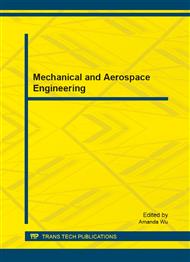[1]
M. Young, S. Keith, and A. Pancotti, An overview of advanced concepts for near space systems. AIAA Joint Propulsion Conference and exhibit. Colorado, USA, (2009).
DOI: 10.2514/6.2009-4805
Google Scholar
[2]
A. Chu, M. Blackmore, and R. G. Oholendt, A novel concept for stratospheric communications and surveillance. AIAA Balloon System Conference, Williamsburge, USA, (2007).
DOI: 10.2514/6.2007-2601
Google Scholar
[3]
A. Colozza and L. D. James, High-altitude, long-endurance airships for coastal surveillance. NASA/TM-2005-213427, (2005).
Google Scholar
[4]
S. B. V. Gomes, An investigation of the flight dynamics of airships with application to the YEZ-2A. PhD thesis, College of Aeronautics, Cranfield University, (1990).
Google Scholar
[5]
J. B. Mueller and M. A. Paluszek, Development of an aerodynamic model and control law design for a high altitude airship. AIAA Unmanned Unlimited Technical Conference, Workshop and Exhibit. Chicago, USA, (2004).
DOI: 10.2514/6.2004-6479
Google Scholar
[6]
Z. L. Cai, W. D. Qu and Y. G. Xi, Dynamic modeling for airship equipped with ballonets and ballast. " Applied Mathematics and Mechanics. Vol. 26, No. 8, (2008), pp.979-987.
Google Scholar
[7]
Y. W. Li, Modeling and simulation of airship dynamics., Journal of Guidance Control and Dynamics. Vol. 30, No. 6, (2007), pp.1691-1701.
Google Scholar
[8]
Y. Bestaoui and H. Kuhlmann, A Newton-Euler approach to modeling of a quad-rotor autonomous airship–preliminary results., Aerospace Sciences Meeting Including the New Horizons Forum and Aerospace Exposition. Florida, UAS, (2010).
DOI: 10.2514/6.2010-39
Google Scholar
[9]
Y. N. Yang, J. Wu and W. Zheng, Vector modeling and stability analysis of a near-space earth observation platform. Journal of National University of Defense Technology. Vol. 33, No. 3, (2011), pp.28-32.
Google Scholar
[10]
Y. N. Yang, J. Wu and W. Zheng, Adaptive fuzzy sliding mode control for robotic airship with model uncertainty and external disturbance. Journal of Systems Engineering and Electronics. Vol. 23, No. 2, (2012), pp.250-255.
DOI: 10.1109/jsee.2012.00032
Google Scholar
[11]
Y. W. Li, Dynamics modeling and simulation of flexible airship. PhD thesis, Department of Mechanical Engineering McGill University, (2008).
Google Scholar
[12]
T. I. Fossen, Guidance and control of ocean vehicles. New York: Wiley, (1998), pp.5-42.
Google Scholar
[13]
Y. W. Li, M. Nahon and I. Sharf, Dynamics modeling and simulation of flexible airships. AIAA Journal. Vol. 47, No. 3, (2009), pp.592-605.
DOI: 10.2514/1.37455
Google Scholar
[14]
M. Leonard, Hybrid state equations of motion for flexible bodies in terms of quasi-coordinates. Journal of Guidance Control, and Dynamics. Vol. 14, No. 5, (1990), pp.1008-1013.
DOI: 10.2514/3.20743
Google Scholar
[15]
L. Meirovitch and T. Stemple, Hybrid equations of motion for flexible multi-body system using quasi-coordinate. AIAA-93-3767-CP, (1993).
Google Scholar
[16]
Z. L. Cai, Research on dynamical modeling and nonlinear control of a stratospheric airship. PhD thesis, Shanghai Jiao Tong University, (2006).
Google Scholar
[17]
S. I. Sagatun and T. I. Fossen, Lagrangian formulation of underwater vehicles dynamics. IEEE Conference on Decision Aiding for Complex System. Trondheim, Norway, (1991).
DOI: 10.1109/icsmc.1991.169823
Google Scholar
[18]
Y. N. Yang, J. Wu and W. Zheng, Trajectory tracking for an autonomous airship using fuzzy adaptive sliding mode control. Journal of Zhejiang University-SCIENCE C (2012).
DOI: 10.1631/jzus.c1100371
Google Scholar


